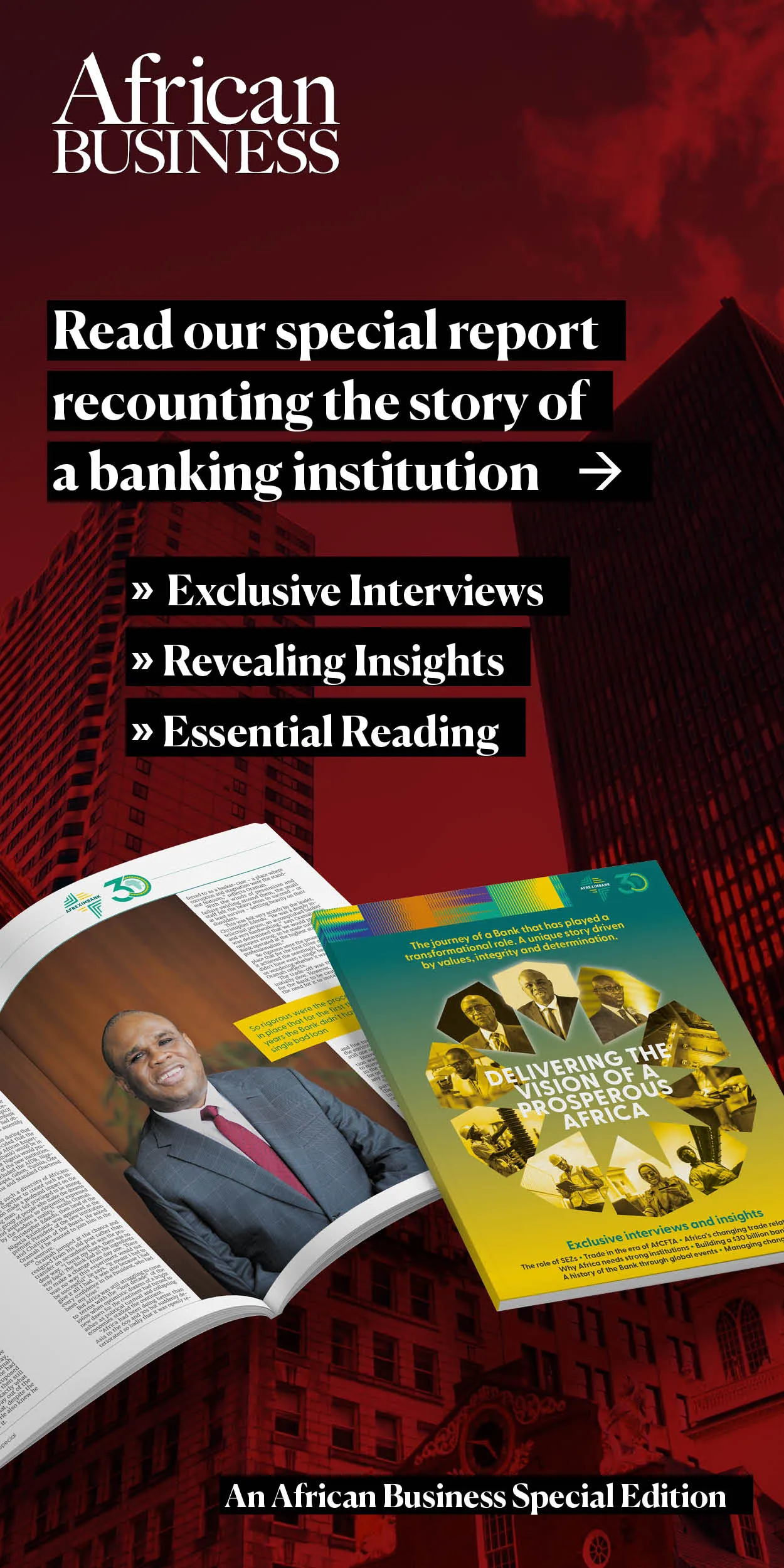This article was produced with the support of Afreximbank
Africa’s low industrial base presents an opportunity to develop clean energy manufacturing and the world’s first green industrial civilisation, Professor Oluyemi Oluleke Osinbajo, immediate past vice president of Nigeria, argued in the eighth Babacar Ndiaye Lecture in Washington DC on 26 October. The annual lecture celebrates the achievements and legacy of the late Ndiaye, who led the African Development Bank from 1985 to 1995. Ndiaye is also credited with the establishment of many African institutions such as Shelter Afrique, the African Business Roundtable and the African Export-Import Bank, organisers of the lecture.
Speaking before Osinbajo, Professor Benedict Okey Oramah, president of Afreximbank, paid tribute to Ndiaye, whose “conviction led him to conceive and lead the creation of several pro-African institutions endowed with unique features that gave them a fighting chance against the violence of dependence and the instability of divide and conquer that had kept Africa and Africans down for decades”. Due to Ndiaye’s foresight, he said, these institutions have been available to support African countries through various crises since the 1980s. “During most of these crises, African multilateral financial institutions created through Dr. Ndiaye’s efforts, such as Afreximbank, played key roles in mitigating the impacts.
Oramah said Ndiaye believed that “climate change is the greatest threat to development, particularly in Africa, where millions of people depend on the environment for their livelihoods.”
The Free Trade Area as a solution
Oramah presented the African Continental Free Trade Area (AfCFTA) as a solution to address climate change; one that does not undermine the continent’s trade and economic growth. He noted that the agreement, signed in 2018 and effective from the following year, offers Africa a means to reduce its carbon emissions by fostering industrial activities within the continent. “By keeping value addition local,” Oramah said, “AfCFTA helps to cut down on the emissions generated from shipping raw materials to distant locations for processing and then re-importing them.”
Speaking on “Saving Lives Today versus Saving the Planet for the Future: Can the AfCFTA Resolve the Climate Change Dilemma?” Osinbajo acknowledged the climate threat that Africa faces pointing out that “the Horn of Africa has been facing its worst drought in 40 years, with five consecutive failed rainy seasons since 2020.” This is in spite of the fact that at 4%, the continent has contributed the least to the global emissions that scientists say are responsible for climate change.
Osinbajo noted that “over a third of Africa’s population lives in extreme poverty,” with population growth outpacing GDP gains. Africa’s reliance on resource-intensive sectors such as agriculture, mining, and energy not only drive economic activity but also contribute to environmental degradation. Africa’s leaders are therefore caught in difficult trade-offs, balancing the urgent need to grow these sectors against the environmental costs.
The costs of fossil fuel divestment
Noting that many African countries rely on fossil fuels to meet energy needs and for producer nations to finance their budget, Osinbajo wondered about moves such as the World Bank’s decision to halt funding for upstream oil and gas projects in Africa. “The implications of these actions are dire,” he warned, emphasising that for many African countries, immediate alternatives to fossil fuels are either unavailable or prohibitively expensive.
Studies suggest that divestment could drastically impact national GDPs, with projected reductions of $30 billion for Nigeria, $22 billion for Algeria, and $19.3 billion for Angola. For gas-rich but energy-poor African countries, Osinbajo argued that gas remains a crucial transition fuel.
Obinsajo argued that Africa should embrace a carbon-negative approach, making it a “climate-positive” powerhouse instead of a contributor to global warming. With 60% of the world’s renewable energy potential, “we can develop the first green industrial civilization. We can indeed green global manufacturing and supply chains. We can protect our carbon sinks and remove carbon from the air at the same time,” Osinbajo argued.
Green industrialisation with the AfCFTA
Turning to the central question of the lecture, Osinbajo noted that the AfCFTA can support Africa’s climate positive growth agenda to drive job creation and green industrialisation across the continent. The agreement, which he describes as the “world’s largest free trade area by participating countries,” establishes a single market of 1.3 billion people and a combined GDP of $3.7 trillion by removing 97% of tariff lines and eliminating trade barriers on 90% of trade goods and services within Africa.
The AfCFTA, Osinbajo said, has two environmental advantages: local beneficiation and emission reduction from reduced shipping. With 42% of African nations now mandating the local processing of raw materials, there will have to be more local production, which will retain jobs and revenue within Africa. Additionally, intra-African trade reduces the need to export raw materials for overseas processing, a practice that drives substantial shipping-related CO2 emissions. “Intra-African trade in finished goods,” he noted, “will substantially reduce this massive cause of global emissions.”
Economically viable solutions
Fortunately, recent data affirms the economic viability of these solutions. A report by the International Energy Agency found the cost per kWh for grid-scale solar, including storage, now falls below that of gas technology. Remarkably, he added, this remains true “even without valuing fossil fuel price volatility and without putting a price on emissions”.
Osinbajo pointed to the development and export of low-carbon fuels, such as hydrogen and ammonia, as a transformative opportunity for African economies. “In the past five years, we have seen many green hydrogen projects in Africa reaching Final Investment Decision,” he noted.
Osinbajo laid out six critical steps that he believes African countries need to pursue for a climate-positive growth path in trade and manufacturing. First is the importance of Africa acting collectively to shape global policy rather than passively following it. “We need to speak with one voice and show up as shapers and not just takers,” he said.
Second, he stressed the importance of internal reform, for African nations to strengthen transparency, accountability, democratic processes and security.
Osinbajo urged African governments to anchor their economic growth and development plans on green opportunities. Another priority he highlighted was harmonising trade, environmental, and industrial policies across African countries to ensure fair competition within the AfCFTA. He also stressed the need for stronger African capital markets and financial institutions, which he views as key to attracting investment.
Finally, Osinbajo pointed to the development of critical infrastructure as fundamental to supporting industry and trade. He highlighted Afreximbank’s involvement in financing cross-border infrastructure projects such as the Tanzania’s Standard-Gauge Railway.
“Today, real and perceived risk factors mean that our cost of capital is much higher than elsewhere, and it’s undoing much, if not all, of our innate climate competitiveness,” he observed. He called for developed countries to honour their commitments made under the Paris Agreement, particularly the activation of the loss and damage fund and the promised $100bn per year in climate finance for developing nations.
Osinbajo advocated a significant overhaul of the international financial architecture, proposing a “debt relief for a green and inclusive recovery project” that aims to provide African countries the space to invest in climate resilience and essential services like health and education. He also emphasised the need for “new and additional sources of finance, investment capital and liquidity through perhaps new levies, carbon prices, and taxation”.

 Sign in with Google
Sign in with Google 
